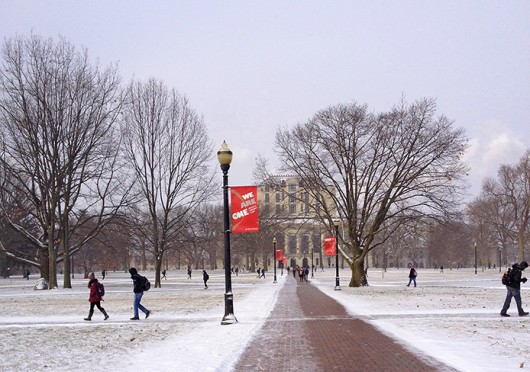
People walk across a snowy Oval Jan. 21. Temperatures are expected to fall as low as 10 degrees Jan. 22.
Credit: Shelby Lum / Photo editor
With temperatures forecasted to fall as low as minus 2 in Columbus this week, some climatologists are looking back in time to see what weather might be ahead.
Two weeks ago, Ohio State called off classes Jan. 6 and 7 because of extreme weather conditions as temperatures fell to minus 7, according to Weather Underground.
“Some people say (the weather was) coldest since 1994 but I think this was worse than ‘94 … just because the winds were so strong. It was simply dangerous to be outside,” said Jeff Rogers, state climatologist and professor in the OSU Department of Geography, Jan. 10.
OSU’s Columbus campus was closed Jan. 19, 1994, because of “extreme cold and snow combined,” Administration and Planning spokeswoman Lindsay Komlanc said in an email.
Rogers said extreme temperatures like those experienced in early January are a result of bitter cold air from the north and strong winds that sweep across the level surface of Ohio.
“It was just painful to have your face exposed to the wind for even a few seconds,” Rogers said. Similar periods of bitter cold have been known to last weeks or months, but as of Friday, temperatures hadn’t been particularly out of the ordinary, he said.
“So far (this year) it’s balanced out to about normal. We had a few abnormally warm days in December, a couple days with extreme lows … followed by temperatures in the 50s, so compared to other years, this winter has been pretty normal,” Rogers said Friday. “Some winters are blocked, some winters have rapidly changing weather. This winter, we’re going to get both of them in one year.”
Rogers added, though, he thinks the weather will be worse than usual in the coming weeks.
“I think that we’re in line for colder than usual (temperatures) and snowier than usual weather for the next couple weeks,” he said.
Wednesday’s forecast predicted a high of 16 degrees and a low of 10, according to the Weather Channel.
Cold weather can pose a threat to the function of university facilities as well as student, faculty and staff safety. There were several water main breaks around campus after the temperatures fell, including one near Macquigg Laboratory and one in Pomerene Hall, leading to some roads covered with ice being closed, Komlanc said Jan. 10.
“Salt is pretty much ineffective at those temperatures, so (workers) had to … chip the ice away before the (roads) could be opened again,” Komlanc said about the break near Macquigg Laboratory Jan. 7, which led to the temporary closure of Woodruff Avenue.
Plumbing issues affected some off-campus students as well.
Fourth-year in sociology Emily Miller and her roommates were unable to use the toilet in their house on Frambes Avenue for about 24 hours Jan. 7 because of a frozen pipe. They adjusted the heat by plugging a small space heater in the bathroom until the plumbing thawed.
Miller said Tuesday she and her roommates are worried the same thing will happen again.
“If it gets as cold as it was the first week of classes, (frozen pipes) are bound to happen again. If not in our apartment, than others’ too,” she said. “Our landlord still hasn’t sent anyone out to check on our pipes, even though he told us he would. So hopefully it doesn’t happen again.”


